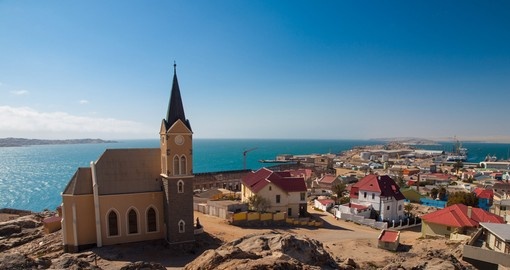Namibia History
There is little known about the earliest history of Namibia because the tribes that lived there heavily relied on oral tradition. It was not until European arrival that accounts and histories were written down. In spite of this, rock paintings found in the south and in Twyfelfontein date back to around 26,000 BC. The first known inhabitants of Namibia were the Bushmen or San people who were hunters and gatherers living a nomadic lifestyle. Historians believe that the San were the only inhabitants in Namibia up until 2,000 years ago. Around that time, the Nama people arrived and settled along the Orange River. By the 9th century AD, the Damara people settled in the grasslands which today are known as Damaraland. No one is certain where the Damara came from as they have no cultural relationships with any other tribes in Africa.
Due to Namibia’s relatively barren and inhospitable coastlines, it remained of little interest to European explorers on the hunt for prosperous new lands. Portuguese sailors were the first to arrive in the late 15th century, however, they were only interested in a route to the Indies and as such, the only testament to their time in Namibia are stone crosses that served as navigational markers. It wasn’t until the 19th century that traders and settlers from Germany and Sweden arrived. The last-minute scramble for colonies saw Germany annex Namibia at the end of the 19th century. The first few years of the 20th century witnessed a rebellion led by the Herero people who were then joined by the Nama, however, the rebellion was severely suppressed.
During the First World War, the Portuguese, fighting for the Allies, overran Namibia. As a result, Namibia’s status as a German colony ended after German forces surrendered to the South African army. South Africa was then given a mandate by the League of Nations to rule the territory. After their desire to annex Namibia was denied, South Africa took a firmer stance in the country. In 1949 they granted parliamentary representation to the white population and parcelled out most of Namibia’s viable farmland to white settlers. This left the indigenous populations to live in ‘reserves’.
The 1950s witnessed the development of nationalism due to the oppression and forced labour that had happened since German annexation. Political parties began to form, culminating in the establishment of the South West Africa People’s Organisation (Swapo) in 1960. The UN decided to conclude the South African mandate during the 1970s, setting up the Commission for Namibia to administer the territory. Swapo initiated guerilla warfare tactics that were brought down by the South African government. The early 1980s saw different political groups attempt to assert power in Namibia, however, control of the country was eventually given back to the South African-appointed administrator general.
South Africa refused to negotiate an UN-backed plan for independence while there were Cuban forces in Angola. In response, Swapo stepped up guerilla attacks. The economy was suffering and all factions of society were frustrated. Eventually, the UN, the United States, the USSR and South Africa struck a deal which saw Cuban forces leave Angola and South African forces leave Namibia. This deal was followed by UN-sanctioned elections in November 1989. A new constitution was adopted in February 1990 and independence was granted the following month under Swapo president Sam Nujoma.
Nujoma served until 2004 when he retired, being replaced by Hifikepunye Pohamba. Pohamba pursued land reforms and strived for national reconciliation. Today, Namibia is immensely affected by the HIV/Aids virus, but the government is taking steps to manage the problem beginning with heavily educating the population. Despite this, Namibia has enjoyed peace, a stable government and economic recovery since independence. It is now one of the prime travel destinations in Africa and is praised the world over for its incredible wildlife and for its dedicated commitment to conservation and ecotourism.
Namibia Travel Information
At Goway we believe that a well-informed traveller is a safer traveller. With this in mind, we have compiled an easy-to-navigate travel information section dedicated to Namibia.
Learn about the history and culture of Namibia, the must-try food and drink, and what to pack in your suitcase. Read about Namibia's nature and wildlife, weather and geography, along with 'Country Quickfacts' compiled by our travel experts. Our globetrotting tips, as well as our visa and health information, will help ensure you're properly prepared for a safe and enjoyable trip. The only way you could possibly learn more is by embarking on your journey and discovering Namibia for yourself. Start exploring… book one of our Namibia tours today!
Extend Your Trip
After your Africa tours, why not consider one of Goway's Europe tours or Egypt tours en route from Namibia or perhaps a stopover in Dubai on one of our United Arab Emirates tours
Book your Namibia tour with Goway!
 AfricaExperts is the exclusive division of Goway that specializes in planning and organizing Namibia tours and experiences. Choose from an exclusive African safari, an independent travel module, a city stopover, a self-drive tour, a rail journey and more. We want to be your first choice when next you go globetrotting to Namibia.
AfricaExperts is the exclusive division of Goway that specializes in planning and organizing Namibia tours and experiences. Choose from an exclusive African safari, an independent travel module, a city stopover, a self-drive tour, a rail journey and more. We want to be your first choice when next you go globetrotting to Namibia.
Get a Trip Quote Order a Brochure

















